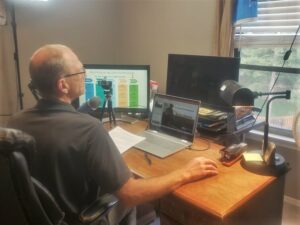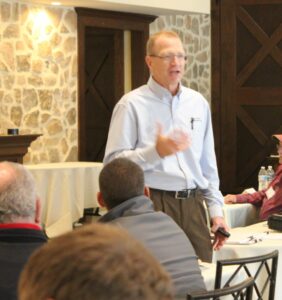Want your Feed sales person to develop into a high performing, self-driven sales success? Think Coaching. It doesn’t replace traditional management or leadership of your team. However, Coaching is an integral part of both of these activities. Management and Leadership concepts have been around the business world since the first goods and services were bartered. Throughout the 1980’s & 90’s, mentoring became a hot topic for business professionals to help career development. Over the last decade, a new concept -coaching- sprang up as a means of developing the sales team.
Many of us intend to coach, but often revert back to management to quickly get the job done. What is quick is slow and what is slow is quick. This works in the short term and in certain situations is needed.
Coaching the Ag Sales Professional, specifically the feed sales person is slightly different than most coaching environments. It’s remote. The Ag profession is spread out all across the globe and sales people are spread out as well. As a manager, we often don’t have the luxury of coaching face to face. To reduce expenses, we limit the number of sales meetings, face-to-face meetings, ride alongs or other forms of coming together. This poses the issue, how do I become effective at coaching a remote team.
So, what is Coaching and how is it different? We’ll cover more in depth coaching concepts in future blogs, but there’s one fundamental aspect that identifies coaching. That one aspect is Internally driven versus external feedback. Managing often involves external feedback and sharing your observations of the sales person. Coaching involves a process of pulling the information out of the person being coached. This internal driven process provides the person with
- Greater understanding of their beliefs, actions, results
- Increased personal accountability for their actions-results
- Increases the rate of change and engagement in their personal development
Coaching for the Feed Sales Person
- Make it routine – Weekly phone calls are best to accelerate change. Same coaching day, same coaching hour – week over week and don’t cancel them. Show your sales professional how important their development is by keeping the time scheduled. Much of Ag sales activities are seasonal. Obviously avoid the busiest season if the situation dictates.
- Keep a running log of what you covered in previous sessions, what you agreed on and what action items you both agreed the sales person would complete by the next phone call. There’s nothing worse than not preparing for the coaching session. Again, show your sincerity to the coaching program by preparing for it.
- It’s a marathon – not a sprint (unless there are major behavior/performance issues). Steady progress is better than no progress and is more sustainable over time. Baby Steps – Take it slow and steady in the beginning.
- Ride Alongs- For the Ag Sales Person, this is the best way to determine what is going on during their sales calls. It’s never exactly the same as when the sales person is one on one with their customer. A third person changes the dynamics of the farm call depending on how it’s handled.
- As the coach/evaluator – never take over the call unless total disaster occurs. Even then, only in rare cases.
- Introduce yourself and explain your role in the company. The farmer wants to know who you are and how you fit into the company.
- After introductions, quickly get the focus back on the sales person or the farming operation. Then let the sales person jump back in.
- I am reluctant to hand out my business card on ride alongs. I want to keep the company contact with the sales person. I never want to give the wrong impression that the customer can now get answers from me. For one, as a sales manager, you don’t have the time. Secondly and more importantly, you want to keep the authority/power/respect with the sales person.
- Plan the ride along in advance with your sales person.
- Don’t go to the same customers every ride along
- Don’t go to the really easy customers that don’t give you a view of the sales persons’ skills
- Don’t just go to the customer that’s angry and wants to chew on management. Certainly go if needed to keep or calm a customer down. But don’t make that a part of the coaching ride along every time.
- Do go to see a customer/prospect that will give you a view of the behavior you are coaching on.
- Do go to customers that are part of the top 20% of your sales person’s customer list.
- Do plan 30 minutes in advance of the call to review the pre-call plan with your sales person.
- Do plan at least 30 minutes after the call to evaluate how the call went.
- Monitoring performance and behaviors – Coaching without some measures around performance or some form of evaluating behaviors is not as effective. Agree on this ahead of time. Set the ground rules on what is needed. Let the sales person tell you the measure they think is acceptable. Then, work from there to mutually agree. Sales $, Tons sold, gross margin sold, number of pre-call plans done, # of prospects in the pipeline, etc.
- 360 feedbacks – One of the most powerful forms of feedback that you can use as a manager. While peer evaluation/feedback is extremely Important for any of us and can be used anytime, I found it very helpful when you are struggling to get through to a more stubborn individual that either doesn’t believe or understand your feedback. Somehow, hearing it from their peers and coworkers hits close to home.
- Peer Ride Alongs – This is a great development tool. A couple of key points:
- Help facilitate the ride along. Many sales people are a little shy about calling another sales person out of the blue and asking to ride along with them
- Match your sales person with the right sales person to ride along with. It’s tempting to have them ride with the highest performing sales person or the closest geographically to them. Both might be ok, but look for sales people that possess the behaviors that you are working on with your sales person. It might not be the person at the top of the sales charts.
- Have them ride with at least two other sales people (3-4 over the course of a year is better). This gives your sales person a better reference and increases the amount of professional sharing and connecting that will go on with your team.
See future blogs on Strategic Coaching, as well as stories of my best/worst experiences in coaching the Ag Sales Teams



